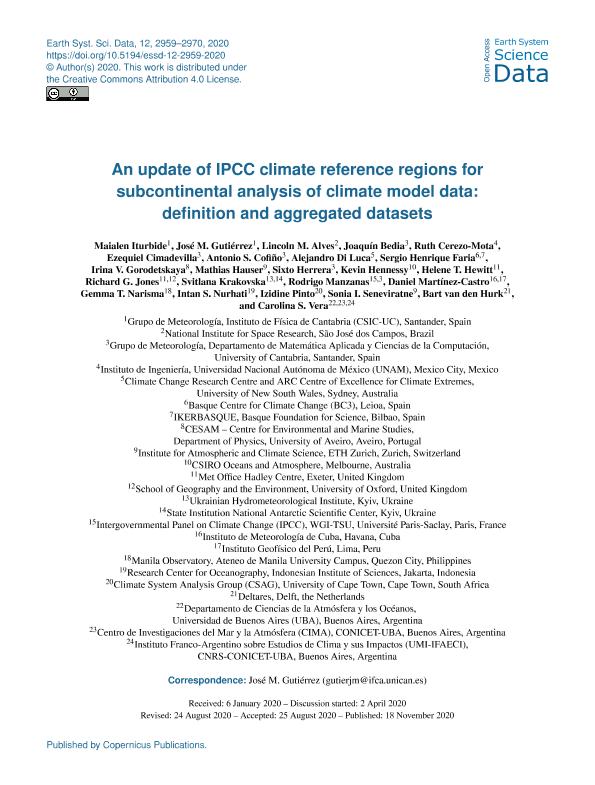Artículo
An update of IPCC climate reference regions for subcontinental analysis of climate model data: definition and aggregated datasets
Iturbide, Maialen; Gutiérrez, José M.; Alves, Lincoln M.; Bedia, Joaquín; Cerezo Mota, Ruth; Cimadevilla, Ezequiel; Cofiño, Antonio S.; Di Luca, Alejandro; Faria, Sergio Henrique; Gorodetskaya, Irina V.; Hauser, Mathias; Herrera, Sixto; Hennessy, Kevin; Hewitt, Helene T.; Jones, Richard G.; Krakovska, Svitlana; Manzanas, Rodrigo; Martínez Castro, Daniel; Narisma, Gemma T.; Nurhati, Intan S.; Pinto, Izidine; Seneviratne, Sonia I.; Van den Hurk, Bart; Vera, Carolina Susana

Fecha de publicación:
11/2020
Editorial:
Copernicus Publications
Revista:
Earth System Science Data
ISSN:
1866-3508
e-ISSN:
1866-3516
Idioma:
Inglés
Tipo de recurso:
Artículo publicado
Clasificación temática:
Resumen
Several sets of reference regions have been used in the literature for the regional synthesis of observed and modelled climate and climate change information. A popular example is the series of reference regions used in the Intergovernmental Panel on Climate Change (IPCC) Special Report on Managing the Risks of Extreme Events and Disasters to Advance Climate Adaptation (SREX). The SREX regions were slightly modified for the Fifth Assessment Report of the IPCC and used for reporting subcontinental observed and projected changes over a reduced number (33) of climatologically consistent regions encompassing a representative number of grid boxes. These regions are intended to allow analysis of atmospheric data over broad land or ocean regions and have been used as the basis for several popular spatially aggregated datasets, such as the Seasonal Mean Temperature and Precipitation in IPCC Regions for CMIP5 dataset. We present an updated version of the reference regions for the analysis of new observed and simulated datasets (including CMIP6) which offer an opportunity for refinement due to the higher atmospheric model resolution. As a result, the number of land and ocean regions is increased to 46 and 15, respectively, better representing consistent regional climate features. The paper describes the rationale for the definition of the new regions and analyses their homogeneity. The regions are defined as polygons and are provided as coordinates and a shapefile together with companion R and Python notebooks to illustrate their use in practical problems (e.g. calculating regional averages).We also describe the generation of a new dataset with monthly temperature and precipitation, spatially aggregated in the new regions, currently for CMIP5 and CMIP6, to be extended to other datasets in the future (including observations). The use of these reference regions, dataset and code is illustrated through a worked example using scatter plots to offer guidance on the likely range of future climate change at the scale of the reference regions.
Palabras clave:
CLIMATE CHANGE
,
IPCC
,
CLIMATE REFERENCE REGIONS
Archivos asociados
Licencia
Identificadores
Colecciones
Articulos(CIMA)
Articulos de CENTRO DE INVESTIGACIONES DEL MAR Y LA ATMOSFERA
Articulos de CENTRO DE INVESTIGACIONES DEL MAR Y LA ATMOSFERA
Citación
Iturbide, Maialen; Gutiérrez, José M.; Alves, Lincoln M.; Bedia, Joaquín; Cerezo Mota, Ruth; et al.; An update of IPCC climate reference regions for subcontinental analysis of climate model data: definition and aggregated datasets; Copernicus Publications; Earth System Science Data; 12; 4; 11-2020; 2959-2970
Compartir
Altmétricas



